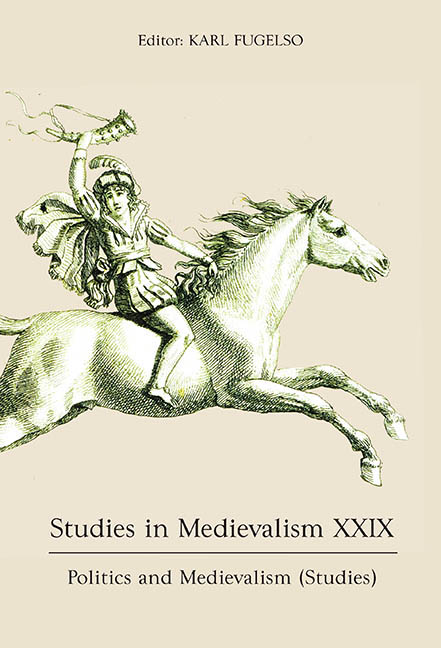Book contents
- Frontmatter
- Studies in Medievalism
- Acknowledgments
- Contents
- List of Illustrations
- Preface
- I Essays on Politics and Medievalism (Studies)
- Historical Malapropism and the Medieval Blood Libel in American Politics
- Putin’s Medieval Weapons in the War against Ukraine
- The Battle of Tours and the US Southern Border
- Medievalism, Brexit, and the Myth of Nations
- An Arthur for the Brexit Era: Joe Cornish’s The Kid Who Would be King
- II Other Responses to Medievalism
- Angle-ing for Arthur: Erasing the Welsh in Guy Ritchie’s King Arthur: Legend of the Sword
- Chasing Freyja: Rape, Immigration, and the Medieval in Alt-Right Discourse
- “Things painted on the coarse canvas”: Political Polemic in Jean-Paul Laurens’s Portrait of the Child Emperor Honorius
- Longfellow and Old English
- Archaeology and Medievalism at Julian of Norwich’s Anchorite Cell
- A Revelation of Love: Christianity, Julian of Norwich, and Medieval Pity in the Harry Potter Series
- In the Beginning Was the Word: How Medieval Text Became Fantasy Maps
- Objectivity, Impossibility, and Laughter in Doctor Who’s “Robot of Sherwood”
- Sonic Medievalism, World Building, and Cultural Identity in Fantasy Video Games
- Contributors
- Miscellaneous Endmatter
Angle-ing for Arthur: Erasing the Welsh in Guy Ritchie’s King Arthur: Legend of the Sword
Published online by Cambridge University Press: 19 August 2020
- Frontmatter
- Studies in Medievalism
- Acknowledgments
- Contents
- List of Illustrations
- Preface
- I Essays on Politics and Medievalism (Studies)
- Historical Malapropism and the Medieval Blood Libel in American Politics
- Putin’s Medieval Weapons in the War against Ukraine
- The Battle of Tours and the US Southern Border
- Medievalism, Brexit, and the Myth of Nations
- An Arthur for the Brexit Era: Joe Cornish’s The Kid Who Would be King
- II Other Responses to Medievalism
- Angle-ing for Arthur: Erasing the Welsh in Guy Ritchie’s King Arthur: Legend of the Sword
- Chasing Freyja: Rape, Immigration, and the Medieval in Alt-Right Discourse
- “Things painted on the coarse canvas”: Political Polemic in Jean-Paul Laurens’s Portrait of the Child Emperor Honorius
- Longfellow and Old English
- Archaeology and Medievalism at Julian of Norwich’s Anchorite Cell
- A Revelation of Love: Christianity, Julian of Norwich, and Medieval Pity in the Harry Potter Series
- In the Beginning Was the Word: How Medieval Text Became Fantasy Maps
- Objectivity, Impossibility, and Laughter in Doctor Who’s “Robot of Sherwood”
- Sonic Medievalism, World Building, and Cultural Identity in Fantasy Video Games
- Contributors
- Miscellaneous Endmatter
Summary
In King Arthur: Legend of the Sword, Guy Ritchie exhibits a puckish delight in torqueing his received material, a habit he displays as well in earlier films like Sherlock Holmes. In his latest venture, Ritchie and his co-writers, Joby Harold and Lionel Wigram, take a crowbar to the myth, jettisoning timelines and disrupting family trees. Mordred, for instance, loses his standing as Arthur's bastard child, becoming instead an evil necromancer pitted against Arthur's father, Uther Pendragon (chap. 1). Vortigern, in contrast, gains a familial connection, for Ritchie recasts him as Arthur's power-mad uncle, one so intent on preventing Arthur's ascension that the wicked usurper willingly sacrifices his own daughter to his warped cause (chap. 10).
Not satisfied with making just these startling revisions, Ritchie chooses to rework the legend further by melding bits of other stories into his Arthurian base. In doing so, he makes use of a “neomedieva[l]” technique, in which artists blithely mix and match materials from a wide variety of eras, displaying little concern for fidelity to the historical record. Ritchie thus connects his work to earlier films like Monty Python and the Holy Grail and The Knight's Tale, which likewise play fast and loose with their received materials. In King Arthur, the director evokes Moses by having his young king discovered alone in a boat (chap. 1). Additionally, the scantily clad damsels of Londinium who find the future hero look like they have arrived fresh off the set of Cecile B. DeMille's famed epic about the Hebrew patriarch, The Ten Commandments. Ritchie also incorporates a healthy dose of Robin Hood into his retelling of Arthurian lore, prompting the reviewer for The Economist to wonder why the director did not just go “whole hog” and name his movie after the notorious English outlaw instead. Ritchie's echoing of the Sherwood-forest outlaw in his depiction of Arthur enables him, potentially, to increase his audience base by appealing to aficionados of both legends. The merging of Arthur and Robin Hood also heightens the film's irreverent nature, not just by making the storied king a rabble-rouser, but also by conflating the Arthurian literary tradition with the folkloric one of the Merry Men.
- Type
- Chapter
- Information
- Studies in Medievalism XXIXPolitics and Medievalism (Studies), pp. 49 - 66Publisher: Boydell & BrewerPrint publication year: 2020



